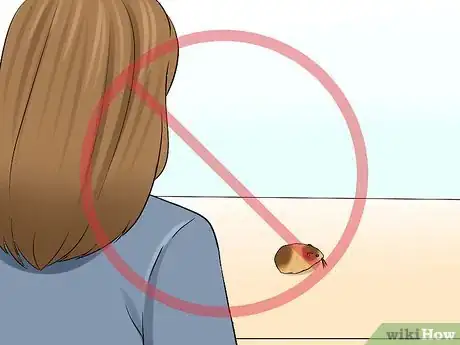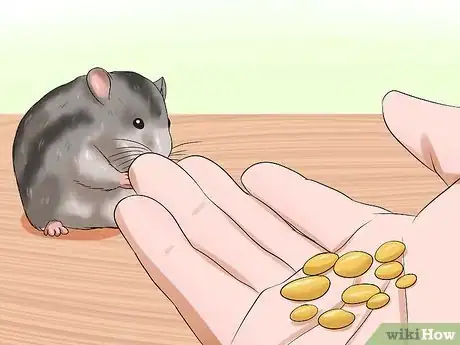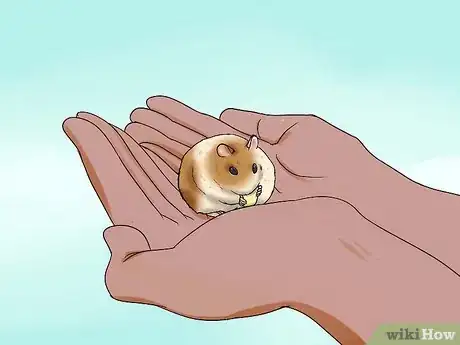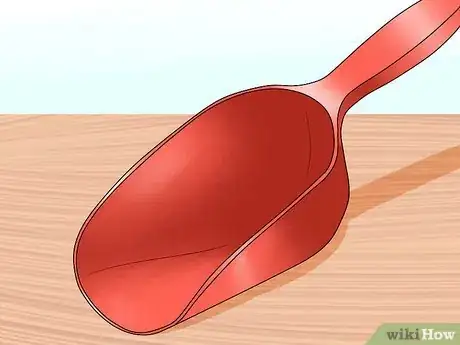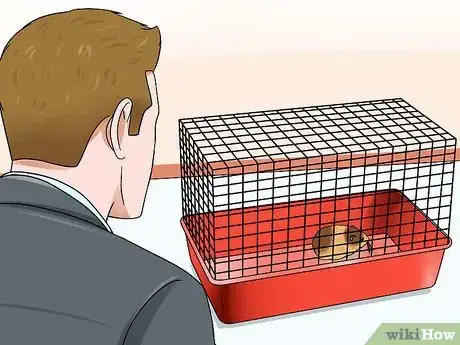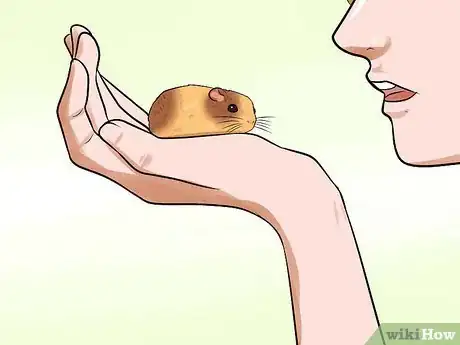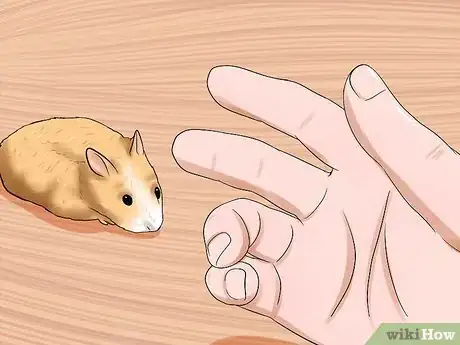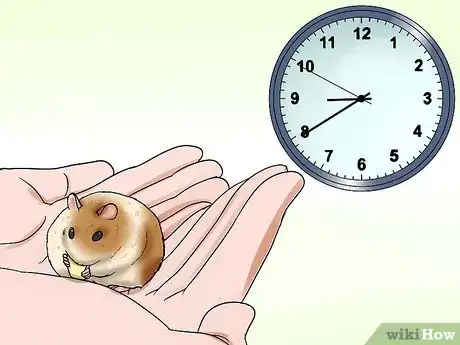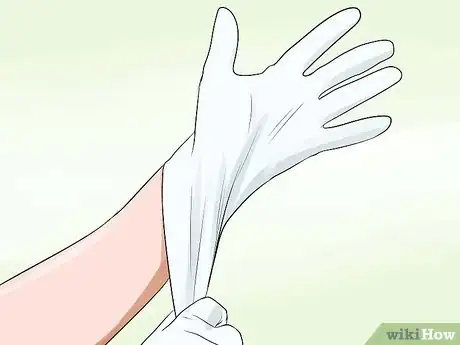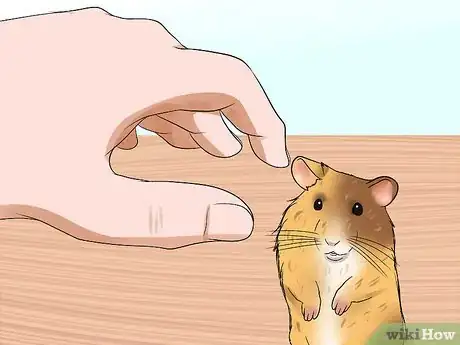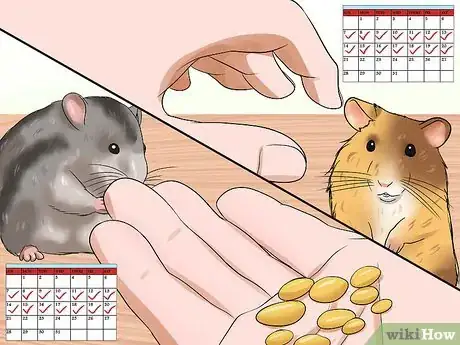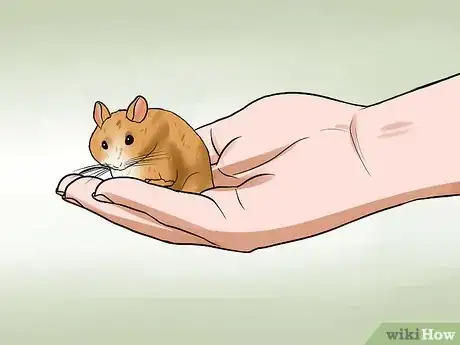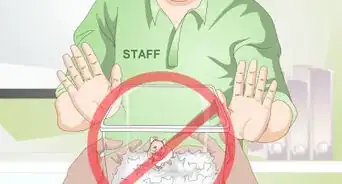This article was co-authored by Pippa Elliott, MRCVS. Dr. Elliott, BVMS, MRCVS is a veterinarian with over 30 years of experience in veterinary surgery and companion animal practice. She graduated from the University of Glasgow in 1987 with a degree in veterinary medicine and surgery. She has worked at the same animal clinic in her hometown for over 20 years.
wikiHow marks an article as reader-approved once it receives enough positive feedback. In this case, several readers have written to tell us that this article was helpful to them, earning it our reader-approved status.
This article has been viewed 78,833 times.
Hamsters are small, fuzzy rodents that make excellent pets. Many hamsters, particularly the more aggressive dwarf hamsters, are prone to biting. Fortunately, this defense mechanism becomes less powerful the more a hamster becomes comfortable in their space. You will be able to handle your hamster without being bitten if you handle them with care, take the time to acclimate your hamster, and train them not to bite.
Steps
Handling Your Hamster
-
1Wash your hands. Before you attempt to pick up your hamster, it is important for you to wash your hands. If your hands smell like food, cosmetics, or anything else scented, your hamster will be much more likely to nibble. Also, by washing your hands before handling them, you will keep your hamster safe from germs.[1]
-
2Avoid sneaking up on them. Hamsters will become aggressive whenever they are frightened. You can avoid being bitten by your hamster if you do not startle them. Anytime you are going to handle them, be sure that they can see you coming. Show them your hands and let them smell you before you attempt to pick them up.Advertisement
-
3Lure them into your hand with a treat. If you reach right into your hamster’s cage and grab them, this will likely make them defensive. Instead, entice your hamster to come to you. Hold out a treat (such as a sunflower seed) and allow your hamster to come and take it. With a second treat, lure your hamster to walk onto the open palm of your other hand. Then lift them out of the cage.[2]
- Hamsters have poor eyesight, so avoid holding treats between your fingers. If you do this, the hamster may mistakenly bite your finger instead of the food.
-
4Hold them with both hands. In order to keep your hamster calm, you must hold him properly. Hold him in one hand with your fingers gently curled under his belly. Your other hand should be supporting his bottom. When you pick up your hamster, always use both hands.[3]
-
5Use a “scoop” to transfer them. Hamsters will become especially defensive when you snatch them out of their cages. You can prevent them biting you by using a scoop to remove them from their cages, instead of your hand. This is particularly useful for anytime you must move them quickly. You can purchase a scoop from a pet store, or cut a two-liter bottle in half to make a DIY scoop.
Acclimating a New Hamster
-
1Leave them alone for a few days. Anytime a hamster moves to a new home, he will experience some fear and anxiety. Allow your hamster to settle in for few days after you bring him home. Don't try to pick him up during this time. Once his new home is comfortable and familiar, he will grow less aggressive and be more open to training and interaction.[4]
-
2Talk to your hamster. Hamsters are quite farsighted, which means they have trouble seeing things that are close up. To compensate for this, hamsters have an excellent sense of hearing. In order to help your hamster get used to you, allow them to grow accustomed to your voice. Put on some music and sing near your hamsters cage, take a phone call in the same room, or simply speak directly to your hamster.[5]
-
3Get them used to your scent. In addition to excellent hearing, hamsters make up for their poor eyesight with a strong sense of smell. Another way for your hamster to get used to you is to get them accustomed to your scent. Simply sit near the cage for a little while each day, or place a hamper of your dirty clothes near the hamster’s cage. [6]
-
4Set a time. Set a specific time to work with your hamster each day. Hamsters are nocturnal creatures, meaning that they will sleep during the day and wake at night. Select a time in the evening when your hamster will be awake, and make a commitment to work with your hamster every day at this time. If you do this consistently for about two weeks, you will have no trouble handling a very tame and gentle hamster.
-
5Wear gloves. If you must handle a hamster before he is trained, be sure to wear gloves to keep yourself safe. Any kind of gloves (such as disposable gloves, dishwashing gloves, or winter gloves) will work just fine.[7]
Training Your Hamster Not to Bite
-
1Go to a quiet place. Once you have gotten your hamster out of their cage, take them a quiet place. Go someplace small, where they can’t get lost, and where this isn’t anything that could hurt them. Usually a good place for this is the bathroom.[8]
-
2Interact with your hamster. Set your hamster on your lap and allow them to crawl on you. Interact with your hamster using slow, gentle movements. It is important to avoid making the hamster anxious and therefore aggressive. Anytime you play with your hamster, keep your motions even and smooth. [9]
-
3Blow in their face. Anytime the hamster comes close to biting you, you can discipline them by blowing in their face. One, brisk exhale into your hamsters face should deter them from biting, and act as a form a discipline to help show him that biting is wrong.
-
4Interact with them regularly. Each night at your designated “hamster time,” take your hamster out of their cage and interact with them 10-20 minutes. When you are finished, gently transfer them back into their cage. Do this each night for two weeks.[10]
-
5Be patient. If you stick to program and spend quality time with your hamster each night, they will most certainly become tame and refrain from biting. It will take some patience, however, because this will not happen overnight. If you become frustrated with your hamster, they are likely to become frustrated as well. Stay calm, and they will stay calm too.
References
- ↑ http://russiandwarfhamsters.tripod.com/hams/id32.html
- ↑ https://www.youtube.com/watch?v=nul1kCaygjU&ab_channel=bubbleblow
- ↑ http://www.habitrail.com/ovo/eng/petcare/taming.php?color=white
- ↑ http://animals.mom.me/expect-new-hamster-1040.html
- ↑ http://www.habitrail.com/ovo/eng/petcare/taming.php?color=white
- ↑ http://www.habitrail.com/ovo/eng/petcare/taming.php?color=white
- ↑ http://animals.mom.me/expect-new-hamster-1040.html
- ↑ http://www.habitrail.com/ovo/eng/petcare/taming.php?color=white
- ↑ http://animals.mom.me/expect-new-hamster-1040.html

